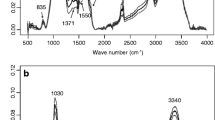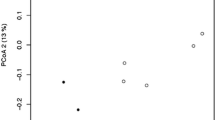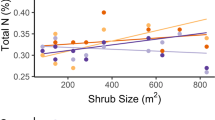Abstract
In boreal peatlands, the aboveground (plant) and belowground (microbial) communities are acutely linked because the whole soil profile is partially decomposed plant matter (peat), and dictates the nutrients available to the belowground system. We characterized the aboveground and belowground communities in two boreal peatlands: a Sphagnum-dominated fen and a Carex-dominated fen. We link the plant and microbial communities by observing plant, litter and peat carbon and nitrogen values. The Sphagnum-dominated fen had greater plant diversity but provided low quality litter inputs (high carbon:nitrogen) that formed peat and that corresponded with greater fungi:bacteria and Gram-positive:Gram-negative bacteria microbial community compared to the Carex-dominated fen. The higher quality plant inputs in the Carex-dominated fen supported a 5 × greater microbial biomass that was also 2 × more active (as measure by CO2 production). In this approach we highlight that peatlands and their component plant and microbial communities play-out along a common resource-spectrum that dictates ‘fast’ vs ‘slow’ carbon and nutrient cycling (i.e., a plant–soil interaction spectrum) that can, in turn, affect carbon storage potential. As peatland plant community composition is predicted to shift and decomposition rates are expected to increase under climate change, our work highlights the importance of understanding plant–soil microbial interactions.





Similar content being viewed by others
Data availability
All data are available from the authors upon request.
References
Aerts R, Wallén B, Malmer N, De Caluwe H (2001) Nutritional constraints on Sphagnum-growth and potential decay in northern peatlands. J Ecol 89:292–299. https://doi.org/10.1046/j.1365-2745.2001.00539.x
Andersen R, Poulin M, Borcard D, Laiho R, Laine J, Vasander H, Tuittila ET (2011) Environmental control and spatial structures in peatland vegetation. J Veg Sci 22:878–890. https://doi.org/10.1111/j.1654-1103.2011.01295.x
Asemaninejad A, Thorn RG, Branfireun BA, Lindo Z (2019) Vertical stratification of peatland microbial communities follows a gradient of functional types across hummock–hollow microtopographies. Écoscience 26:249–258. https://doi.org/10.1080/11956860.2019.1595932
Asemaninejad A, Thorn RG, Lindo Z (2017) Vertical distribution of fungi in hollows and hummocks of boreal peatlands. Fungal Ecol 27:59–68. https://doi.org/10.1016/j.funeco.2017.02.002
Averill C, Turner BL, Finzi AC (2014) Mycorrhiza-mediated competition between plants and decomposers drives soil carbon storage. Nature 505:543–545. https://doi.org/10.1038/nature12901
Bardgett RD, van der Putten WH (2014) Belowground biodiversity and ecosystem functioning. Nature 515:505–511. https://doi.org/10.1038/nature13855
Bligh EG, Dyer WJ (1959) A rapid method of total lipid extraction and purification. Can J Biochem Physiol 37:911–917
Bond-Lamberty B, Bailey VL, Chen M, Gough CM, Vargas R (2018) Globally rising soil heterotrophic respiration over recent decades. Nature 560:80–83. https://doi.org/10.1038/s41586-018-0358-x
Bond-Lamberty B, Gower ST (2007) Estimation of stand-level leaf area for boreal bryophytes. Oecologia 151:584–592. https://doi.org/10.1007/s00442-006-0619-5
Borga P, Nilsson M, Tunlid A (1994) Bacterial communities in peat in relation to botanical composition as revealed by phospholipid fatty acid analysis. Soil Biol Biochem 26:841–848. https://doi.org/10.1016/0038-0717(94)90300-X
Bragazza L, Bardgett RD, Mitchell EAD, Buttler A (2015) Linking soil microbial communities to vascular plant abundance along a climate gradient. New Phytol 205:1175–1182. https://doi.org/10.1111/nph.13116
Bragazza L, Buttler A, Robroek BJM, Albrecht R, Zaccone C, Jassey VEJ, Signarbieux C (2016) Persistent high temperature and low precipitation reduce peat carbon accumulation. Glob Change Biol 22:4114–4123. https://doi.org/10.1111/gcb.13319
Brzostek ER, Greco A, Drake JE, Finzi AC (2013) Root carbon inputs to the rhizosphere stimulate extracellular enzyme activity and increase nitrogen availability in temperate forest soils. Biogeochemistry 115:65–76. https://doi.org/10.1007/s10533-012-9818-9
Buyer JS, Teasdale JR, Roberts DP, Zasada IA, Maul JE (2010) Factors affecting soil microbial community structure in tomato cropping systems. Soil Biol Biochem 42:831–841. https://doi.org/10.1016/j.soilbio.2010.01.020
Carlson ML, Flagstad LA, Gillet F, Mitchell EAD (2010) Community development along a proglacial chronosequence: are above-ground and below-ground community structure controlled more by biotic than abiotic factors? J Ecol 98:1084–1095. https://doi.org/10.1111/j.1365-2745.2010.01699.x
Cornwell WK, Bedford BL, Chapin CT (2001) Occurrence of arbuscular mycorrhizal fungi in a phosphorus-poor wetland and mycorrhizal response to phosphorus fertilization. Am J Bot 88:1824–1829. https://doi.org/10.2307/3558359
de Vries FT, Caruso T (2016) Eating from the same plate? Revisiting the role of labile carbon inputs in the soil food web. Soil Biol Biochem 102:4–9. https://doi.org/10.1016/j.soilbio.2016.06.023
Del Giudice R, Lindo Z (2017) Short-term leaching dynamics of three peatland plant species reveals how shifts in plant communities may affect decomposition processes. Geoderma 285:110–116. https://doi.org/10.1016/j.geoderma.2016.09.028
Dieleman CM, Branfireun BA, McLaughlin JW, Lindo Z (2015) Climate change drives a shift in peatland ecosystem plant community: Implications for ecosystem function and stability. Glob Change Biol 21:388–395. https://doi.org/10.1111/gcb.12643
Dorrepaal E, Cornelissen JHC, Aerts R, Wallén B, Van Logstestijn RSP (2005) Are growth forms consistent predictors of leaf litter quality and decomposability across peatlands along a latitudinal gradient? J Ecol 93:817–828. https://doi.org/10.1111/j.1365-2745.2005.01024.x
Eckstein R, Karlsson P, Weih M (1999) Leaf life span and nutrient resorption as determinants of plant nutrient conservation in temperate-arctic regions. New Phytol 143:177–189
Eisenhauer N (2012) Aboveground-belowground interactions as a source of complementarity effects in biodiversity experiments. Plant Soil 351:1–22. https://doi.org/10.1007/s11104-011-1027-0
Fan H, Wu J, Liu W, Yuan Y, Hu L, Cai Q (2015) Linkages of plant and soil C:N: P stoichiometry and their relationships to forest growth in subtropical plantations. Plant Soil 392:127–138. https://doi.org/10.1007/s11104-015-2444-2
Fanin N, Kardol P, Farrell M, Nilsson MC, Gundale MJ, Wardle DA (2019) The ratio of Gram-positive to Gram-negative bacterial PLFA markers as an indicator of carbon availability in organic soils. Soil Biol Biochem 128:111–114. https://doi.org/10.1016/j.soilbio.2018.10.010
Frostegård A, Bååth E (1996) The use of phospholipid fatty acid analysis to estimate bacterial and fungal biomass in soil. Biol Fertil Soils 22:59–65
Gorham E (1991) Northern peatlands: role in the carbon cycle and probable responses to climatic warming. Ecol Appl 1(2):182–195
Grime JP (1974) Vegetation classification by reference to strategies. Nature 250:26–31. https://doi.org/10.1038/250026a0
Grime JP (1977) Evidence for the existence of three primary strategies in plant and its relevance to ecological and evolutionary theory. Am Nat 111:1169–1194. https://doi.org/10.1103/PhysRevE.76.042103
Grime JP, Rincon ER, Wickerson BE (1990) Bryophytes and plant strategy theory. Bot J Linn Soc 104:175–186. https://doi.org/10.1111/j.1095-8339.1990.tb02217.x
Guillermo Bueno C, Gerz M, Zobel M, Moora M (2019) Conceptual differences lead to divergent trait estimates in empirical and taxonomic approaches to plant mycorrhizal trait assignment. Mycorrhiza 29:1–11. https://doi.org/10.1007/s00572-018-0869-1
Hagedorn F, Gavazov K, Alexander JM (2019) Above- and belowground linkages shape responses of mountain vegetation to climate change. Science 365:1119–1123. https://doi.org/10.1126/science.aax4737
Hättenschwiler S, Tiunov AV, Scheu S (2005) Biodiversity and litter decomposition in terrestrial ecosystems. Annu Rev Ecol Evol Syst 36:191–218. https://doi.org/10.1146/annurev.ecolsys.36.112904.151932
Haynes KM, Preston MD, McLaughlin JW, Webster K, Basiliko N (2015) Dissimilar bacterial and fungal decomposer communities across rich to poor fen peatlands exhibit functional redundancy. Can J Soil Sci 95:219–230. https://doi.org/10.4141/cjss-2014-062
Jaatinen K, Fritze H, Laine J, Laiho R (2006) Effects of short- and long-term water-level drawdown on the populations and activity of aerobic decomposers in a boreal peatland. Glob Change Biol 13:491–510. https://doi.org/10.1111/j.1365-2486.2006.01312.x
Jacquemart A (1998) Andromeda polifolia Andromède. J Ecol 86:527–541
Jassey VE, Chiapusio G, Binet P, Buttler A, Laggoun-Défarge F, Delarue F, Bernard N, Mitchell EA, Toussaint ML, Francez AJ, Gilbert D (2013) Above- and belowground linkages in Sphagnum peatland: climate warming affects plant-microbial interactions. Glob Change Biol 19:811–823. https://doi.org/10.1111/gcb.12075
Jenkinson DS, Adams DE, Wild A (1991) Model estimates of CO2 emissions from soil in response to global warming. Nature 351:304–306. https://doi.org/10.1038/351304a0
Joergensen RG, Wichern F (2008) Quantitative assessment of the fungal contribution to microbial tissue in soil. Soil Biol Biochem 40:2977–2991. https://doi.org/10.1016/j.soilbio.2008.08.017
Keddy P, Fraser LH, Wisheu IC (1998) A comparative approach to examine competitive response of 48 wetland plant species. J Veg Sci 9:777–786. https://doi.org/10.2307/3237043
Kramer C, Gleixner G (2008) Soil organic matter in soil depth profiles: distinct carbon preferences of microbial groups during carbon transformation. Soil Biol Biochem 40:425–433. https://doi.org/10.1016/j.soilbio.2007.09.016
Li H, Wang X, Liang C, Hao Z, Zhou L, Ma S, Li X, Yang S, Yao F, Jiang Y (2015) Aboveground-belowground biodiversity linkages differ in early and late successional temperate forests. Sci Rep 5:1–11. https://doi.org/10.1038/srep12234
Malik AA, Chowdhury S, Schlager V, Oliver A, Puissant J, Vazquez PGM, Jehmlich N, von Bergen M, Griffiths RI, Gleixner G (2016) Soil fungal: Bacterial ratios are linked to altered carbon cycling. Front Microbiol 7:1–11. https://doi.org/10.3389/fmicb.2016.01247
Mallegård H, Stalheim T, Hormazabal V, Granum PR, Hardy SP (2009) Antibacterial activity of sphagnum acid and other phenolic compounds found in Sphagnum papillosum against food-borne bacteria. Lett Appl Microbiol 49:85–90. https://doi.org/10.1111/j.1472-765X.2009.02622.x
Manzoni S, Trofymow JA, Jackson RB, Porporato A (2010) Stoichiometric controls on carbon, nitrogen, and phosphorus dynamics in decomposing litter. Ecol Monogr 80:89–106. https://doi.org/10.1890/09-0179.1
Mentzer JL, Goodman RM, Balser TC (2006) Microbial response over time to hydrologic and fertilization treatments in a simulated wet prairie. Plant Soil 284:85–100. https://doi.org/10.1007/s11104-006-0032-1
Miller RM, Smith CI, Jastrow JD, Bever JD (1999) Mycorrhizal status of the genus Carex (Cyperaceae). Am J Bot 86:547–553. https://doi.org/10.2307/2656816
Muthukumar T, Udaiyan K, Shanmughavel P (2004) Mycorrhiza in sedges: an overview. Mycorrhiza 14:65–77. https://doi.org/10.1007/s00572-004-0296-3
Newmaster SG, Harris AG, Kershaw LJ (1997) Wetland plants of Ontario. Lone Pine Press, Edmonton, Canada
Oksanen J, Blanchet FG, Friendly M, Kindt R, Legendre P, McGlinn D, Minchin PR, O'Hara RB, Simpson GL, Solymos P, Stevens MHH, Szoecs E, Wagner H (2018) vegan:Community Ecology Package. R package version 2.5–3. https://CRAN.R-project.org/package=vegan
Orwin KH, Buckland SM, Johnson D, Turner BL, Smart S, Oakley S, Bardgett RD (2010) Linkages of plant traits to soil properties and the functioning of temperate grassland. J Ecol 98:1074–1083. https://doi.org/10.1111/j.1365-2745.2010.01679.x
Palozzi JE, Lindo Z (2017a) Boreal peat properties link to plant functional traits of ecosystem engineers. Plant Soil 418:277–291. https://doi.org/10.1007/s11104-017-3291-0
Palozzi JE, Lindo Z (2017b) Pure and mixed litters of Sphagnum and Carex exhibit a home-field advantage in Boreal peatlands. Soil Biol Biochem 115:161–168. https://doi.org/10.1016/j.soilbio.2017.08.026
Porazinska DL, Bardgett RD, Blaauw MB, William HH, Parsons AN, Seastedt TR, Wall DH, (2003) Relationships at the aboveground-belowground interface: plants, soil biota, and soil processes. Ecol Monogr 73:377–395. https://doi.org/10.1890/0012-9615(2003)073[0377:RATAIP]2.0.CO;2
Quideau SA, McIntosh ACS, Norris CE, Lloret E, Swallow MJB, Hannam K (2016) Extraction and analysis of microbial phospholipid fatty acids in soils. J Vis Exp 114:e54360. https://doi.org/10.3791/54360
R Development Core Team (2013) R: a language and environment for statistical computing. ISBN 3-900051-07-0. R foundation for statistical computing, Vienna
Reich PB (2014) The world-wide “fast-slow” plant economics spectrum: A traits manifesto. J Ecol 102:275–301. https://doi.org/10.1111/1365-2745.12211
Robroek BJM, Wubs ERJ, Martí M, Zając K, Andersen JP, Andersson A, Börjesson G, Bragazza L, Dise NB, Keuskamp JA, Larsson M, Lindgren PE, Mattiasson P, Solomonsson J, Sundberg C, Svensson BH, Verhoeven JTA (2014) Microclimatological consequences for plant and microbial composition in Sphagnum-dominated peatlands. Boreal Environ Res 19:195–208
Rydin H, Jeglum JK (2013) The biology of peatlands, 2nd edn. Oxford University Press, Oxford
Schnitzer SA, Klironomos JN, HilleRisLambers J, Kinkel LL, Reich PB, Xiao K, Rillig MC, Sikes BA, Callaway RM, Mangan SA, van Nes EH, Scheffer M (2011) Soil microbes drive the classic plant diversity–productivity pattern. Ecology 92:296–303. https://doi.org/10.2307/41151139
Schwintzer CR (1979) Nitrogen fixation by Myrica gale root nodules Massachusetts wetland. Oecologia 43:283–294. https://doi.org/10.1007/BF00344955
Shanmugam SG, Kingery WL (2018) Changes in soil microbial community structure in relation to plant succession and soil properties during 4000 years of pedogenesis. Eur J Soil Biol 88:80–88. https://doi.org/10.1016/j.ejsobi.2018.07.003
Skene KR, Sprent JI, Raven JA, Herdman L (2000) Myrica gale L. J Ecol 88:1079–1094. https://doi.org/10.1046/j.1365-2745.2000.00522.x
Sprent JI, Scott R, Perry KM (1978) The nitrogen economy of Myrica gale in the field. J Ecol 66:657–668
StatSoft Inc, 2004. Statistica (Data Analysis Software System), Version 7.0 (Tulsa, USA).
Straková P, Anttila J, Spetz P, Kitunen V, Tapanila T, Laiho R (2010) Litter quality and its response to water level drawdown in boreal peatlands at plant species and community level. Plant Soil 335:501–520. https://doi.org/10.1007/s11104-010-0447-6
Strickland MS, Lauber C, Fierer N, Bradford MA (2009a) Testing the functional significance of microbial community composition. Ecology 90:441–451. https://doi.org/10.1890/08-0296.1
Strickland MS, Osburn E, Lauber C, Fierer N, Bradford MA (2009b) Litter quality is in the eye of the beholder: Initial decomposition rates as a function of inoculum characteristics. Funct Ecol 23:627–636. https://doi.org/10.1111/j.1365-2435.2008.01515.x
Strickland MS, Rousk J (2010) Considering fungal:bacterial dominance in soils – Methods, controls, and ecosystem implications. Soil Biol Biochem 42:1385–1395. https://doi.org/10.1016/j.soilbio.2010.05.007
Sun T, Zhang H, Wang Z (2019) Reply to Tedersoo et al.: Plant species within the same family or genus can have different mycorrhizal types? Proc Natl Acad Sci 116:12141–12142. https://doi.org/10.1073/pnas.1903868116
Szajdak LW, Meysner T, Inisheva LI, Lapshina E, Szczepański M, Gaca W (2019) Dynamics of organic matter and mineral components in Sphagnum- and Carex-dominated organic soils. Mires Peat 24(26):1–15. https://doi.org/10.19189/MaP.2019.BG.StA.1754
Tedersoo L, Rahimlou S, Brundrett M (2019) Misallocation of mycorrhizal traits leads to misleading results. Proc Natl Acad Sci 116:201903178. https://doi.org/10.1073/pnas.1903178116
Thormann MN, Currah RS, Bayley SE (1999) The mycorrhizal status of the dominant vegetation along a peatland gradient in southern boreal Alberta, Canada. Wetlands 19:438–450
Turetsky MR (2003) The role of bryophytes in carbon and nitrogen cycling. Bryologist 106(3):95–409.
Turetsky MR, Crow SE, Evans RJ, Vitt DH, Wieder RK (2008) Trade-offs in resource allocation among moss species control decomposition in boreal peatlands. J Ecol 96:1297–1305. https://doi.org/10.1111/j.1365-2745.2008.01438.x
van der Heijden MGA, Bardgett RD, Van Straalen NM (2008) The unseen majority: Soil microbes as drivers of plant diversity and productivity in terrestrial ecosystems. Ecol Lett 11:296–310. https://doi.org/10.1111/j.1461-0248.2008.01199.x
Verhoeven JT, Liefveld WM (1997) The ecological significance of organochemical in Sphagnum. Acta Bot Neerl 46:117–130
Vile MA, Kelma Wieder RK, Živković T, Scott KD, Vitt DH, Hartsock JA, Iosue CL, Quinn JC, Petix M, Fillingim HM, Popma JMA, Dynarski KA, Jackman TR, Albright CM, Wykoff DD (2014) N2-fixation by methanotrophs sustains carbon and nitrogen accumulation in pristine peatlands. Biogeochemistry 121:317–328. https://doi.org/10.1007/s10533-014-0019-6
Vitousek PM, Howarth RW (1991) Nitrogen limitation on land and in the sea: how can it occur ? Biogeochemistry 13:87–115
Waldrop MP, Firestone MK (2004) Microbial community utilization of recalcitrant and simple carbon compounds: impact of oak-woodland plant communities. Oecologia 138:275–284. https://doi.org/10.1007/s00442-003-1419-9
Wang M, Moore TR (2014) Carbon, nitrogen. phosphorus, and potassium stoichiometry in an ombrotrophic peatland reflects plant functional type. Ecosystems 17:673–684. https://doi.org/10.1007/s10021-014-9752-x
Wardle DA, Bardgett RD, Klironomos JN, Setälä H, van der Putten WH, Wall DH (2004) Ecological linkages between aboveground and belowground biota. Science 304:1629–1633
Wardle DA, Bonner KI, Barker GM, Yeates GW, Nicholson KS, Bardgett RD, Watson RN, Ghani A (1999) Plant removals in perennial grassland: vegetation dynamics, decomposers, soil biodiversity, and ecosystem properties. Ecol Monogr 69:535–568. https://doi.org/10.1890/0012-9615(1999)069[0535:PRIPGV]2.0.CO;2
Wardle DA, Bonner KI, Nicholson KS (1997) Biodiversity and plant litter: experimental evidence which does not support the view that enhanced species richness improves ecossytem function. Oikos 79:247–258. https://doi.org/10.2307/3546010
Wardle DA, Yeates GW, Barker GM, Bonner KI (2006) The influence of plant litter diversity on decomposer abundance and diversity. Soil Biol Biochem 38:1052–1062. https://doi.org/10.1016/j.soilbio.2005.09.003
Waring BG, Averill C, Hawkes CV (2013) Differences in fungal and bacterial physiology alter soil carbon and nitrogen cycling: insights from meta-analysis and theoretical models. Ecol Lett 16:887–894. https://doi.org/10.1111/ele.12125
Webster KL, McLaughlin JW (2010) Importance of the water table in controlling dissolved carbon along a fen nutrient gradient. Soil Sci Soc Am J 74:2254. https://doi.org/10.2136/sssaj2009.0111
Westoby M, Wright IJ (2006) Land-plant ecology on the basis of functional traits. Trends Ecol Evol 21:261–268. https://doi.org/10.1016/j.tree.2006.02.004
Whitaker J, Ostle N, Nottingham AT, Ccahuana A, Salinas N, Bardgett RD, Meir P, McNamara NP (2014) Microbial community composition explains soil respiration responses to changing carbon inputs along an Andes-to-Amazon elevation gradient. J Ecol 102:1058–1071. https://doi.org/10.1111/1365-2745.12247
Wright IJ, Reich PB, Westoby M, Ackerly DD, Baruch Z, Bongers F, Cavender-Bares J, Chapin T, Cornelissen JHC, Diemer M, Flexas J, Garnier E, Groom PK, Gulias J, Hikosaka K, Lamont BB, Lee T, Lee W, Lusk C, Midgley JJ, Navas M-L, Niinemets Ü, Oleksyn J, Osada N, Poorter H, Poot P, Prior L, Pyankov VI, Roumet C, Thomas SC, Tjoelker MG, Veneklaas EJ, Villar R (2004) The worldwide leaf economics spectrum. Nature 428:821–827. https://doi.org/10.1038/nature02403
Živković T, Disney K, Moore TR (2017) Variations in nitrogen, phosphorus, and δ 15N in Sphagnum mosses along a climatic and atmospheric deposition gradient in eastern Canada. Botany 95:829–839. https://doi.org/10.1139/cjb-2016-0314
Acknowledgements
We thank the Ontario Ministry of Natural Resources and Forestry (Dr. Jim McLaughlin and Dr. Maara Packalen) for the access to the research sites and Dr. Brian Branfireun for continued support with our research program. We would also like to thank Christian Gallant and Dr. Aaron Mills from Agriculture and Agri-Food Canada for helpful comments and suggestions on the PLFA protocol and GC analysis. We thank Devdutt Kamath, Grace Carscallen, Ting Sun, Madelaine Anderson, Jennifer Blythe, Matthew Meehan and Carlos Barreto for assistance with field data collection. We also thank the two anonymous reviewers and editor for comments that greatly improved our manuscript.
Funding
This work was supported by funding from NSERC (Natural Sciences and Engineering Research Council of Canada) Discovery Grants program to ZL (#418241-2012).
Author information
Authors and Affiliations
Contributions
CLL and ZL conceived and designed the study. CLL performed the study and analyzed the data. CLL and ZL wrote the manuscript.
Corresponding author
Ethics declarations
Conflicts of interest
The authors declare that they have no conflict of interest.
Additional information
Communicated by Lauchlan Fraser.
Publisher's Note
Springer Nature remains neutral with regard to jurisdictional claims in published maps and institutional affiliations.
Electronic supplementary material
Below is the link to the electronic supplementary material.
Rights and permissions
About this article
Cite this article
Lyons, C.L., Lindo, Z. Above- and belowground community linkages in boreal peatlands. Plant Ecol 221, 615–632 (2020). https://doi.org/10.1007/s11258-020-01037-w
Received:
Accepted:
Published:
Issue Date:
DOI: https://doi.org/10.1007/s11258-020-01037-w




